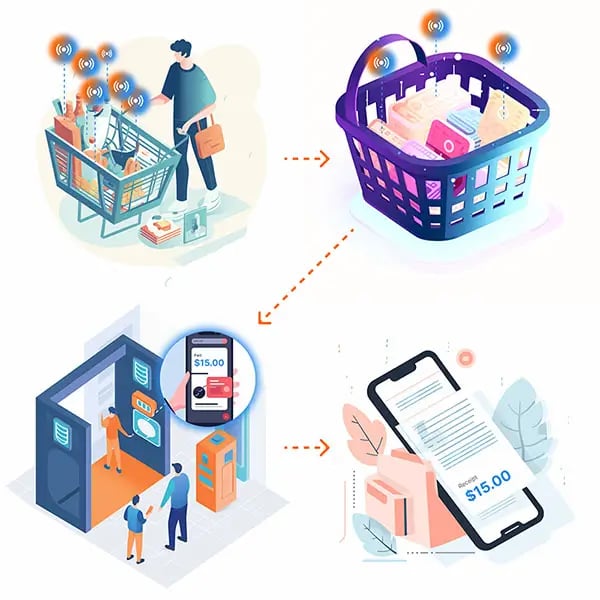The digital world is getting bigger and retail stores are becoming a part of it by using Internet of Things (IoT) technology. As the online and real-world mix, IoT connectivity solutions are becoming a key part of changing how retail works. This mix is revolutionizing how stores operate, making customer interactions better, and opening new chances for businesses to grow. Let's explore the range of opportunities and challenges IoT brings to the retail world.
Making Operations Smooth
Precision Inventory Management
At the heart of retail success lies effective inventory management. IoT connectivity solutions stand as a beacon of innovation in this domain. IoT-powered smart shelves and sensors continuously monitor stock levels in real-time.
They notify managers when stock is low or items are misplaced. This helps prevent stock-outs or overstocking, saving money. These smart systems also help in maintaining an organized store layout by sending alerts for misplaced items, further enhancing the shopping experience.
Over time, the data collected from these IoT devices can help in understanding sales trends. It helps enable better inventory decisions, improving operational efficiency, and enhancing profitability. IoT assists retailers in improving inventory management and staying competitive in the changing retail industry by being more responsive and efficient.
Supply Chain Transparency
A smooth supply chain in retail needs clear visibility, and IoT connectivity solutions provide this clarity. IoT sensors enhance supply chain transparency by providing real-time data. This data includes information on the location and condition of goods. It ensures safe and timely product delivery while reducing potential losses.
By monitoring temperature during transit, especially for items that can spoil, immediate actions can be taken if any issues arise.
Additionally, analyzing the data collected can help identify and rectify systemic issues within the supply chain, improving overall efficiency. The understanding and control given by IoT sensors help retailers save money and make customers happy by always having products available.
Energy Efficiency and Sustainability
As the global conscience veers towards sustainability, retail spaces are no exception. IoT connectivity solutions are at the forefront of driving energy efficiency in retail. By automating lighting and HVAC systems, IoT technology optimizes energy consumption based on real-time conditions such as store occupancy. For instance, lighting can be dimmed during off-peak hours or when natural light is sufficient, and HVAC systems can operate at reduced capacity when foot traffic is low.
Besides energy efficiency, a comfortable in-store environment, maintained through smart temperature and lighting adjustments, enhances the customer experience. The data collected from these systems can also provide insights into customer behavior. This includes identifying busy shopping hours, allowing retailers to further optimize the in-store environment, thus improving customer satisfaction.
Improving Customer Experience
Personalized Shopping
The modern-day retail arena is pivoting towards personalization, with IoT connectivity solutions playing a pivotal role. By collecting data on customer preferences through their browsing and purchasing behaviors, IoT devices enable a tailored shopping experience. Retailers can utilize this data to recommend products and offer discounts based on individual preferences, making shopping more enjoyable.
Moreover, insights from IoT data can also assist in personalizing marketing campaigns and loyalty programs, further enhancing customer engagement and satisfaction. IoT assists retailers in merging online and offline data to create a customized shopping experience. This, in turn, enhances customer loyalty and drives success in the current retail landscape.
Smart Fitting Rooms
The fitting room is a decisive point in a customer's shopping experience. IoT technology allows smart mirrors in fitting rooms to improve the shopping experience. They suggest accessories, offer different sizes or colors, and let customers call for staff help without leaving the room.
Smart mirrors offer virtual try-on features, personalized discounts, and collect customer feedback, making the shopping experience more interactive and enjoyable. By doing so, customer satisfaction is boosted, likely leading to increased sales. Moreover, smart mirrors can collect data that helps retailers improve their products and understand what customers like. This shows how IoT can enhance the retail experience.
Swift Checkout Processes
The checkout process is the final touchpoint in a customer's shopping journey, and IoT is revolutionizing this facet of retail. Through technologies like RFID and computer vision, IoT connectivity solutions are modernizing the traditional checkout process.
Customers can just grab items and leave, and the payment is done automatically. This not only makes shopping more convenient, but also reduces wait times and the need for manual checkouts. Additionally, these technologies provide real-time inventory monitoring and can offer personalized promotions based on the items being purchased. Automating checkout improves customer satisfaction, provides useful data, and may lower operations costs.

Finding New Growth Paths
Data Analytics and Forecasting
In the digital epoch, data is the cornerstone for retailers, and IoT connectivity solutions are the conduits for data collection. Analyzing the plethora of data collected via IoT devices unveils insights into customer preferences, popular products, and effective store layouts.
This data-driven approach aids in better decision-making and future sales predictions. For instance, predictive analytics utilizing IoT data can forecast sales trends and inventory needs, enhancing operational efficiency. Overall, IoT data analytics helps retailers personalize shopping, improve strategies, and gain a competitive edge in the market.
Marketing with Precision
Understanding customer behaviors and preferences is essential for effective marketing, and IoT connectivity solutions help retailers achieving this. By aggregating data through IoT devices, retailers can craft personalized marketing campaigns, which can improve customer engagement and loyalty.
For example, IoT can help in real-time interaction, personalized offers, accurate customer segmentation, and feedback collection on marketing effectiveness. Through tailored marketing strategies based on IoT data, retailers can enhance customer satisfaction, making marketing efforts more impactful and cost-efficient.
Facing Challenges
Security Concerns
The digital transformation comes with a fair share of challenges, with cybersecurity being paramount. Protecting data is important to avoid breaches. They can lead to significant fines and harm a brand's reputation. This is particularly true as stores start using IoT technologies.
It's imperative to implement strong security measures to combat evolving cyber threats. This means following rules like GDPR and CCPA, using encryption, having regular security checks, using multi-step login processes, and always watching for possible threats.
Moreover, teaching employees about security and making sure other companies you work with follow strong security rules are key steps to prevent cyber-attacks and keep sensitive data safe.
Through these measures, retailers can foster consumer trust while navigating the digital landscape securely.
Technology Integration and Cost Management
Adding new IoT solutions to current systems in retail needs a good plan to make sure the technology fits well and data is kept safe. It's crucial to update security protocols to address the evolving threat landscape with the introduction of new technologies. Training staff on the integrated systems is key to leveraging the full potential of IoT technologies. It equips them with the necessary skills to navigate the new systems effectively.
Additionally, continuous monitoring and optimization post-integration ensure the IoT solutions function as intended. Working together with vendors and technology providers, managing costs effectively, and following the law are important for a successful integration. This leads to better operations and improved customer experience.
Adopting IoT in retail requires a substantial initial investment including the cost of devices, integration, and possible system upgrades. It's crucial for retailers to conduct a thorough Return on Investment (ROI) analysis to understand the financial implications. This analysis should compare the total costs against anticipated benefits like operational efficiencies, energy savings, and enhanced customer experiences.
Also, thinking about long-term savings, looking for grants or discounts, and talking with sellers for better deals can help control costs. Training workers, putting money into safety, and keeping an eye on performance are other key parts to make sure the IoT technologies work well and are worth the investment.
Conclusion
The teamwork between IoT and retail is creating a modern shopping scene, supported by better operations, happy customers, and growing businesses. IoT connectivity solutions are leading this change, making operations smoother and providing personalized shopping experiences.
However, moving into the digital world also brings challenges like strong online security and managing costs. It's important to tackle these challenges with a balanced approach, focusing on both security and getting good returns on investment (ROI). IoT is not just changing how retail looks, but is making shopping modern with more options and better interactions between customers and the store.

